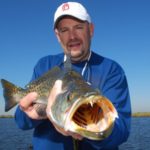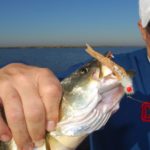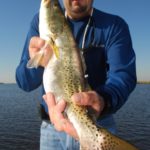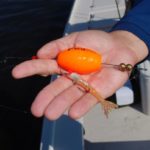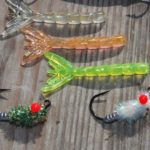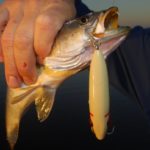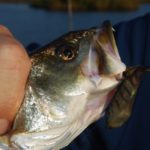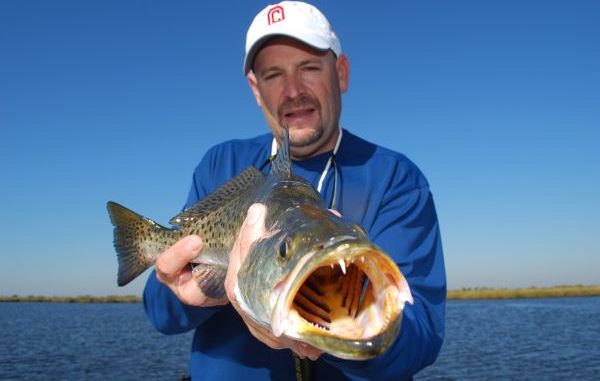
Cold weather doesn’t stop the bite in the Cocodrie area. Follow this guide’s advice to load the boat all month.
So I asked him, “What’s the best speckled trout spot on the central coast in December?”
Before he answered, he fixed his lazer-like eyes on me with a look on his face that said, “Everyone knows the answer to that.”
He exhaled slightly and said “Lake Mechant! Lake De Mechant! Lake Mechant!”
“When are we going?” I responded.
I was talking to Bryce Michel, who amongst other things is the owner of Topwater Charters and Lodge in Chauvin. The business employs five charter boats, and the lodge is really two lodges, side-by-side, that can sleep 24 people.
Within a week, we were backing down a Terrebonne Parish boat ramp. While he busied himself readying the big bay boat for launching, I thought over his last words before I got out of the truck.
“We will have 50 fish in an hour.”
That sounded brash, but like the old saying goes, “It ain’t braggin’ if ya can do it!”
It was a gorgeous morning — not a cloud in the sky — cold and crisp. The only troubling thing was a brisk 10- to 15-mph wind out of the east. But Michel said that we would be fishing the protected waters of the canals and bayous attached to the lake, rather than in the lake itself.
At the boat launch, two other charter guides, Justin Breaux and Jonathan Martin bolstered my expectations. Martin, sensing my inexperience with the area, said “It’s unbelievable out here! After the cold fronts in late October and early November, the fish feed in big schools. They will cover an acre, and you can throw a hot dog and catch them.”
Wow!
The ride to Bayou Chevreau, where he would be fishing today to avoid the wind in Lake Mechant, was brisk enough that I buried my neck in my quad parka. But when he stopped the boat, the morning turned gorgeous. The sharply angled sun high lit the golden brown wintertime marsh vegetation, overarched by a bright, blue sky.
At Michel’s feet on the bow deck were four rods, each rigged for action with his favorite lures: a battle-scarred blue-and-silver Rebel Jointed Minnow, a bone-colored Mirr0lure Top Pup, a brown shrimp Shiney Hiney under an oval rattling cork and a Storm Wildeye swim bait in bluegill color.
The strategy, he explained, would be to throw topwater lures early in the morning, especially if he saw any fish activity on the surface.
He picked up the rod with the Top Pup and began casting and retrieving the lure in walk-the-dog fashion.
The plip-plop of the surface lure was punctuated by the rattling hack of marsh hens hidden in the tall grass and the mutterings of feeding gray ducks in the distance. It was a gorgeous morning, just cool enough to inhibit mosquitoes, but warm enough that I quickly shed my coat. The sulfurous smell of the marsh was pungent and pleasant at the same time.
Speckled trout were regularly taking swipes at his lure, but he wasn’t able to connect.
“They are still a little sluggish this morning,” he muttered, showing some frustration.
Michel, who admits that he is ADD, is a bundle of nervous activity. While casting and retrieving, he was constantly jiggling his legs. Earlier in his truck he admitted that he isn’t a big reader. “You have to sit still too long,” was his explanation.
The finicky bite this morning wasn’t helping. Finally, he nailed a good 1 ½-pounder.
“That’s a little eater,” he noted as he unhooked it.
“I thought good eaters were 13-inchers,” I ventured.
“That all depends who you fish with,” he replied.
With the ice broken, he began connecting regularly with specks. Most were under 2 pounds, but I remembered his cocky prediction made earlier in the morning.
“We will catch all you want,” he had promised. “We’ll catch some 2-pounders and maybe a 4-pounder.”
Unable to be passive, he began refereeing the bite. “That’s a good one,” or “That’s a small one,” and “Oh, a decent fish!”
“It’s incredible here this time of the year,” he said as he unhooked his fourth or fifth trout in just about as many casts. “It’s where all the fish want to move to. We are in the zone!’
But, he admitted semi-ruefully, that the area is “very pressured,” especially on weekends.
“And it’s getting worse on week days. It is what it is — you just gotta accept it,” he shrugged.
He got bored, and then shifted to tossing his broken back Rebel. Interestingly, while the speckled trout had been bashing the Top Pup on the surface, they wouldn’t give the Rebel a second look — until he began making it dive to swim it back to the boat.
Then they whacked it. If one hit it and shook the hook, another grabbed the lure, seemingly within 5 feet of where it pulled loose from the first fish.
It was almost too easy — almost!
Michel made generous use of his trolling motor while he fished. He fished downwind with the unslacking breeze, using his electric motor to keep the boat off the bank, as well as to hold position to fish spots that produced more bites than average.
If a spot seemed especially promising, he spudded down his Power-Pole. When the bite slowed, he would pick up the Power-Pole and begin drifting until he drifted out of fish.
Then he would boat the trolling motor and crank the big motor to return upwind for another drift through the spot.
It didn’t take him long to add another half dozen specks to the ice chest. And he was unceremoniously tossing back all the 12- to 14-inchers (the really good-eaters) as soon as he unhooked them.
The limit was nearly half made and it wasn’t 7 a.m. yet.
Out came the next bait — what he called a swim bait — a Storm Wildeye, in of all things, a bluegill color. This lure he fished with a steady, smooth retrieve — no jerking; no twitching. Retrieval speed was varied to find the fish; the slower the retrieve, the deeper the lure fished.
As a rule, he said, the colder the water temperatures are, the nearer the fish will be to the bottom.
Made sense.
“November and December are my favorite times to fish,” he said in a more-relaxed mode than earlier in the morning. “I love to swim-bait fish, and I love to topwater fish. The fish are closer in (away from the Gulf) because they are in their winter pattern.”
He said when he turned to a swim bait, his first choice was the lure at the end of his line.
“I’m a fan of Storm,” he said. “I like the way it swims. I like the way it throws. I like the way they eat it. I got a lot of confidence in the bait.”
And eat it they did, attacking it with abandon. These specks likely never saw a bluegill in their lives, but they sure liked eating bluegill look-alikes.
Grading them hard and tossing back more than he kept, Michel slipped another half dozen fish into the box.
With only six specks to go before filling his limit, Michel turned to his last rigged rod. It held a brown shrimp Shiney Hiney on a pearl body.
As he cradled it in his hand, he explained, “The owner, Bobby Woodson from near Lafayette, Louisiana showed me these. I tried them and they produce.”
Woodson and his wife Jenny own Jenny’s Jigs. The couple hand-make all their lures, which include Shiney Hiney Shrimp, Shiney Hiney Swim Baits, Redfish Spinner Baits, Redfish Buzz Baits, Speck Spinners, Endura Shrimp, Vibra Glass Minnows and Cajun Dancers, as well as their original lures, Hair Sac-A-Lait Jigs and Tinsel Sac-A-Lait Jigs.
Michel worked this bait hard, popping the devil out of the oval rattling cork. He popped, and they came — one after the other.
As he fished, he talked about lure colors.
“I have confidence in the colors I use, but I believe that color is a personal choice,” he said. “I believe more in finding clean water. Trout are sight feeders. By instinct, if they see something moving that matches what they eat, they will eat it.”
All too soon it was over — and it was barely past 8 a.m. He had released as many legal fish, and some small ones besides, as he has kept. His legs were no longer jiggling as he calmly picked up his trolling motor.
From the far-away look in his eyes, I could tell that he was already planning the rest of his day.
Bryce Michel is one of the 13 top flight speckled trout guides featured in the book Trout Masters Too: How The Pros Do It, available at http://www.shopsportsmanstore.com/ and Amazon, as well as for the Kindle. The charter guides in the book were chosen for their ability to produce speckled trout in numbers and size in the region where they fish. Michel’s business, Topwater Charters and Lodge in Chauvin, may be reached at 985-852-9560 or 985-594-9074.
